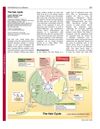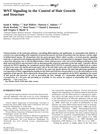Epidermal Patterning and Induction of Different Hair Types During Mouse Embryonic Development
September 2009
in “
Birth defects research
”
Eda/Edar pathway MadCAM-1 Dkk4 Noggin Wnt/βcatenin pathway Troy Sox18 Runx transcription factors hair follicle morphogenesis primary hair follicle induction secondary hair follicle induction tertiary hair follicle induction Ectodysplasin A receptor pathway Wnt/beta-catenin pathway hair follicle development
TLDR Different body areas in mice produce different hair types due to interactions between skin layers.
The study investigated the mechanisms of hair patterning and differentiation during mouse embryonic development, emphasizing the roles of various signaling pathways. Key findings included the crucial role of the Eda/Edar pathway in primary hair follicle induction, with MadCAM-1 and Dkk4 as targets, and the importance of Noggin for secondary and tertiary hair follicle induction. The Wnt/βcatenin pathway, along with Troy, Sox18, and Runx transcription factors, were also significant in hair patterning. The research highlighted the complexity of hair follicle morphogenesis, the influence of body axes on coat patterning, and the need for further investigation into regulatory mechanisms, which have implications for understanding human hair growth and disorders.



